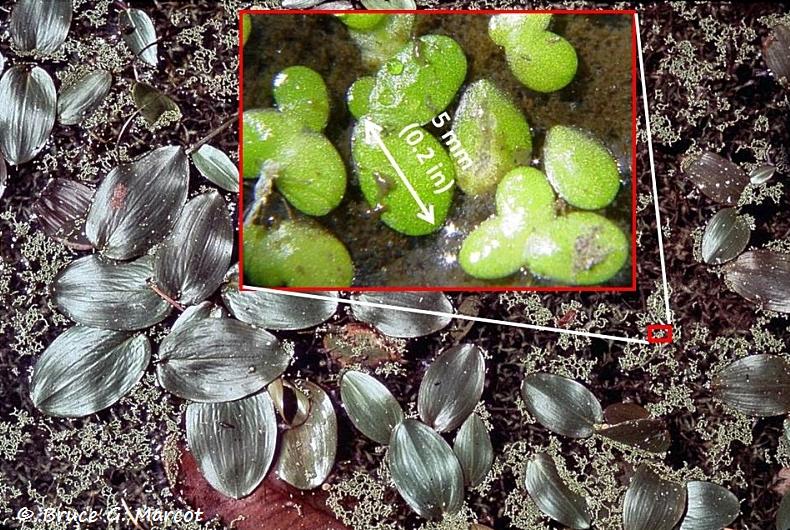
|
|
Tiniest Plant Plays a Big Role |
|
|
Click on images for larger versions
|
Lesser (Common) Duckweed (Lemna
minor), Family Lemnaceae |
Credit & Copyright: Dr. Bruce G. Marcot
Explanation: The tiny dots in the main photo above are one of the world's smallest flowering plants. Floating in a slump pond in the remote Klamath Mountains of northwestern California, USA, is a soup of lesser (or common) duckweed.
Also in the above photo are larger, more clearly veined leaves of broad-leaved (or floating) pondweed (Potamogeton natans) whose leaves utterly dwarf those of lesser duckweed by a factor of being up to 40 times larger. This size difference would be like comparing a human adult to a tiny tree frog. Or comparing a human adult to the height of a four-story building.
Anyhow ... lesser duckweed is surprisingly widespread globally, found in North America, Europe, Africa, southern Asia, and even parts of Australia and New Zealand.
Lesser (common) duckweed is the smallest of several duckweed and
duckweed-like species.
Leaves float flat on the water surface. The species reproduces mostly
by budding, although it can produce amazingly tiny flowers that
span merely 1 mm (0.04 in) across.
Lesser duckweed spreads quickly, is tolerant to a wide range of pH and temperatures, and ... here's the "big role" part ... it is food for a very wide array of aquatic wildlife including insects, ducks, and turtles, and even carp and muskrats. I expect that other generalist species such as nutria also feed at least opportunistically on this plant.
Another big role is that this species can remove excess nutrients and toxins, and thus can be used as a biological cleaner of tainted water bodies.
Further, aggregations of lesser duckweed provide habitat for a variety of aquatic invertebrates.
The downside is that, in profusion, lesser duckweed can deplete oxygen levels of ponds and other water bodies, rendering them uninhabitable by fish.
Every thallus (leaf) has a single thread-like root, seen here in the
upper right of this photo.
Next week's picture:
Guanaco Bush Ablaze
< Previous ... | Archive |
Index |
Location | Search | About EPOW | ... Next >
|
|
Author & Webmaster: Dr.
Bruce G. Marcot
Disclaimers and Legal
Statements
Original material on Ecology Picture of the Week ©
Bruce G. Marcot
Member Theme of The Plexus